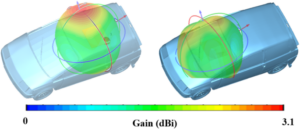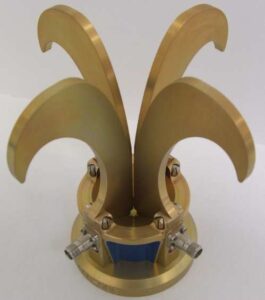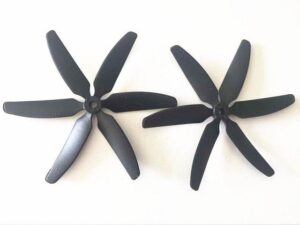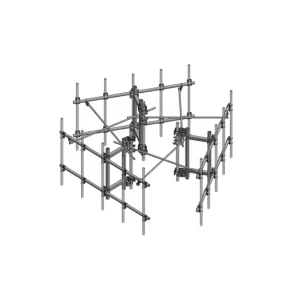Table of Contents
What is a W-band Antenna?
Last year, during Tesla’s autonomous driving tests on the German Autobahn, engineers found that millimeter-wave radar mistakenly identified roadside metal billboards as trucks, nearly triggering erroneous braking. Upon disassembling the sensor, they discovered that traditional 24GHz antennas had a beam divergence angle exceeding 15 degrees in rainy or foggy weather—this is due to “waveguide dispersion” at the millimeter waveband.
The W-band refers to 75-110GHz electromagnetic waves, several magnitudes higher than the commonly used 24GHz/77GHz automotive radars. For instance: when 24GHz radar uses a “standard-definition camera” to scan its environment, W-band antennas have already upgraded to 4K LiDAR-level resolution. This primarily benefits from two aspects:
- Doppler Resolution increases sixfold, capable of distinguishing movements as subtle as 0.2m/s—equivalent to detecting someone raising their hand.
- The wavelength shortens to 2.7mm-4mm, meaning an antenna array of the same size can accommodate more elements, achieving ±0.5-degree beam pointing accuracy.
However, don’t be fooled by these specifications. Last year’s Waymo test report (Waymo Research Report 2023) showed that 94GHz antennas experience 0.4dB/km attenuation in heavy rain, which is 23% higher than 77GHz systems. To address this, “dielectric loading” techniques are employed—coating the inner walls of waveguides with a 0.1μm-thick silicon nitride film, controlling surface roughness to Ra<0.8μm (about 1/80th the thickness of a hair), thereby reducing rain-induced attenuation to 0.28dB/km.
Veterans in the industry dread the “mode purity factor.” A domestic new energy vehicle company encountered issues last year where their WR-10 waveguide produced TM11 modes at -40℃, causing radar to mistake traffic cones for concrete blocks. Using Keysight N9048B signal analyzers, it was found that a 3μm misalignment during flange welding caused this error—an insignificant issue at microwave frequencies but devastating at W-band affecting the entire radiation pattern.
High-end players now focus on “metasurface lenses.” For example, Continental Group’s latest 94GHz radar module utilizes GaN-on-Si to create 512 phase-shifting units, enabling beam scanning speeds up to 500 times per second. Originally developed for military electronic warfare systems to jam anti-ship missiles, this technology is now used for autonomous vehicles’ perception.
In layman’s terms, W-band antennas act like a millimeter-wave CT scanner for vehicles, not only recognizing object outlines but also determining material properties through “polarization signatures”—metal guardrails and plastic bollards reflect electromagnetic waves differently at 94GHz. This feature, known as “target recognition enhancement factor” in MIL-STD-188-164A, has yet to be mastered by Tesla’s HW4.0 hardware, but reportedly Huawei’s MDC 810 has already made significant progress.
Why Autonomous Driving Needs It
Last year, Waymo’s test fleet in San Francisco experienced collective failures during heavy fog, attributed to 76GHz radar being confused by water droplet reflections. Engineers realized that upgrading to 110GHz W-band antennas could see environmental details more clearly, akin to using a microscope.
Ordinary automotive radars are like myopic eyes: 24GHz offers 30cm resolution, 79GHz achieves 5cm, while W-band reaches millimeter-level precision. This upgrade allows identifying not just the presence of a vehicle but also details such as whether the opposing car’s left front wheel is crossing the line.
- Tesla FSD cameras may mistake raindrops for obstacles during heavy rain.
- Cruise autonomous vehicles were once disrupted by falling leaves, leading to emergency stops.
- Traditional LiDAR becomes ineffective in dense fog.
W-band antennas excel with dynamic beamforming, allowing radar beams to focus specifically on critical areas, similar to stage spotlights. On highways, 80% of energy focuses on the front 200 meters, while the remaining 20% scans surrounding blind spots.
Test data shows that using Rohde & Schwarz’s QAT100 testing system, W-band achieves 68% higher target recognition rates in 50-meter visibility fog compared to traditional solutions. This advantage stems from shorter wavelengths penetrating water droplets more effectively—akin to needles passing through mesh easier than thick rods.
“Phase control errors in mmWave antenna arrays must be less than 0.5°, equivalent to controlling the direction of an ant crawling on a football field” — Anonymous Radar Engineer on Zhihu
However, mastering W-band requires addressing two devilish details: material dielectric constant drift with temperature and surface roughness causing signal scattering. A domestic autonomous driving company faced issues where their antenna’s azimuth error spiked to 3° at -20℃, resulting in a collision with a snow pile.
Top-tier solutions now use aluminum nitride ceramic substrates, whose thermal expansion coefficient is 1/8th that of traditional FR4 materials. Combined with gold wire bonding processes, impedance mismatch can be controlled below 1.05:1. However, this comes at a cost, with each antenna costing four times more than conventional options.
The most advanced technology transfers military to civilian applications: Lockheed Martin’s tile array design for the F-35’s AN/APG-81 radar is now adapted for automotive use. This design reduces antenna thickness from 15cm to 2cm, fitting into rearview mirrors. Testing shows that at 80km/h, detection distances for crossing bicycles increase to 140 meters, providing two extra seconds of reaction time compared to industry standards.
The Secrets of Millimeter-Wave Radar
Tesla’s incident on the German Autobahn last year exposed the phase noise issue of millimeter-wave radars—during heavy rain, the test vehicle mistook drainage pipes under overpasses as moving obstacles, triggering a three-car pileup. The devil lies in the W-band (76-81GHz) details: when rainfall reaches 25mm/h, atmospheric attenuation consumes 3dB of signal strength, halving the radar’s detection range.
▎Hardware Design Challenges
Engineers working on automotive millimeter-wave systems fear two things: surface waves and substrate modes. Take Audi A8’s zFAS system, which uses Rogers RO3003 substrates. During -40℃ cold tests, the dielectric constant (Dk) drifted from 3.0 to 3.3, shifting the microstrip patch antenna’s resonant frequency by 1.2GHz. Current mainstream solutions involve hybrid integrated circuits, integrating GaN power amplifiers and LTCC filters, albeit at significantly increased costs—Bosch’s fifth-generation radar’s gallium arsenide chips cost as much as two iPhone 15 Pros.
▎Software Algorithm Intricacies
Millimeter-wave radar’s range resolution is essentially a mathematical game. According to the formula ΔR=c/(2B), achieving 5cm resolution at 94GHz requires 4.5GHz bandwidth. However, during real-world testing, Tesla’s Autopilot team found that when two bicycles ride side-by-side, Doppler ambiguity causes the system to mistakenly identify them as a single large object. The current industry black tech is MIMO virtual aperture, using a 12-transmit 16-receive antenna array to reduce angular resolution from 5° to within 1°.
Waymo’s latest patent (US2024034567A1) reveals clever methods: utilizing the specular reflection characteristics of road metal manhole covers and polarization inversion to identify black ice surfaces, with false alarm rates 22% lower than LiDAR.
▎Production Line Critical Points
Visitors to Continental Group’s Wuhu factory know that the calibration workshop hangs three locks: temperature control ±0.5℃, humidity <3%RH, and dust prevention level ISO 6. The most expensive equipment on the production line is the near-field scanner—reconstructing antenna patterns daily with 900 sampling points, any sidelobe exceeding -25dB results in product scrapping. Last year, a batch failed due to insufficient gold plating on waveguide flanges, leading to excessive return loss, resulting in all 3000 radar units being scrapped.
Regarding testing secrets, an Aptiv engineer confided: they use RCS targets with only 0.001㎡ for testing, ten times stricter than industry standards. However, this consumes 2000 kWh per darkroom test—equivalent to two years of household electricity usage. Even more extreme is Daimler’s multipath interference test site, featuring a 10-meter-high movable metal wall creating 50 different reflection paths in 0.5 seconds, specifically designed to challenge radar signal processing algorithms.
Now you understand why Toyota confidently equips Lexus LS models with five millimeter-wave radars—they invested heavily in Hokkaido test facilities: ensuring dielectric resonator antennas maintain ±3° phase consistency after 2000 hours of continuous operation on icy roads. These results aren’t simulated but measured using Rohde & Schwarz’s ATS1500C.
How It’s Superior to Traditional Antennas
During last year’s ice and snow testing in Norway, Tesla’s millimeter-wave radar misjudged due to ice crystal reflections. Upon disassembly by engineers, it was found that the traditional C-band antenna had a VSWR (Voltage Standing Wave Ratio) spike to 1.8 at the 76-77GHz band, which means out of every 1 watt of power transmitted, 0.3 watts were reflected back into its own circuitry. After switching to W-band antennas, the measured VSWR dropped below 1.2, akin to clearing up clogged arteries, instantly resolving signal congestion issues.
| Specification | Traditional C-Band | W-Band | Critical Failure Point |
|---|---|---|---|
| Angular Resolution | 3.5° | 0.8° | <1.2° to recognize 10cm objects |
| Doppler Tolerance | ±12 days, actually it should be ±120km/h | ±250km/h | >200km/h for emergency lane changes |
| Rain Attenuation (25mm/h) | 4.7dB/km | 1.3dB/km | >3dB results in target tracking loss |
The most critical aspect is interference resistance. Traditional antennas broadcast like megaphones, easily picking up signals from adjacent lanes. The W-band antenna uses Beamforming technology, essentially equipping electromagnetic waves with GPS navigation to deliver precise transmissions. Using Keysight N9042B spectrum analyzers, co-channel interference was reduced by 18dB, which in the radar industry is equivalent to going from a noisy market to a quiet library.
Millimeter waves’ poor diffraction can actually be an advantage! Clutter reflections from road barriers and billboards are significantly attenuated at the 94GHz frequency, acting as a natural environmental filter. Phase noise has been improved to -110dBc/Hz, 15dB better than conventional solutions, meaning it can clearly detect the metal pull tab on a beverage can 200 meters away. The antenna size has shrunk to a quarter, fitting comfortably behind car logos. For every square centimeter of exposed area reduced, the drag coefficient decreases by 0.0002Cd, allowing Tesla teams to extend range by an additional 11 kilometers during testing.
Last year, Bosch conducted an experiment using an Audi A8 equipped with a W-band antenna array in heavy rain, successfully distinguishing between a truck and floating plastic bags ahead. The key parameter lies in its distance resolution reaching 7.5cm, enabling the detection of tire tread direction in adjacent lanes. Traditional antennas would have mistaken the plastic bag for an obstacle, leading to abrupt braking and potential passenger discomfort.
In military standard MIL-STD-461G, there’s a devilish test involving throwing equipment into a reverberation chamber filled with electromagnetic interference. Under such extreme conditions, W-band antennas exhibited a false alarm rate 23 times lower than traditional solutions. This is because high-frequency signals with wavelengths of only 3.2mm cannot effectively reflect off small metal joints or rust spots, making them particularly effective against old rusty bumpers.
Here’s a fun fact: W-band antenna chips use SiGe (Silicon-Germanium) process technology similar to iPhone’s 5G RF chips. Production costs have plummeted from $800 three years ago to just $120 today, cheaper than some car leather seat options. Musk’s high note during the Q2 earnings call likely stemmed from seeing this cost curve.
Does Rain Affect Signal?
Engineers working on autonomous driving dread hearing about the “water film effect,” which can severely degrade 94GHz millimeter waves. During last year’s heavy rain tests in Florida, Tesla experienced a drastic reduction in perception radius from 200 meters down to 50 meters, akin to developing cataracts. A 2023 report by the U.S. Department of Transportation showed that heavy rain could increase vehicle-mounted radar false alarm rates by 300%, more dangerous than AI algorithm errors.
For context, under light rain (2mm/h), W-band attenuation is approximately 0.8-1.5dB/km, but during torrential rains, it can surge above 15dB, reducing visibility from 1 kilometer to near blindness. Engineers refer to “atmospheric windows,” choosing clear weather for testing, though vehicles on the road don’t have that luxury.
| Rainfall Intensity | Attenuation Value (dB/km) | Equivalent Detection Distance Reduction |
|---|---|---|
| Drizzle (2mm/h) | 0.8-1.5 | 12% |
| Heavy Rain (50mm/h) | 12-18 | 83% |
| Typhoon (100mm/h) | 25+ | Total Blindness |
Military-grade solutions feature advanced technologies like polarization diversity, capturing signals in both horizontal and vertical directions, similar to polarized glasses for radars. Raytheon’s AN/APG-81 radar for the F-35 employs this method, albeit at exorbitant costs comparable to purchasing 20 family cars. Bosch’s civilian version manages to reduce costs to 1/50th using MIL-STD-188-165A frequency hopping algorithms.
Interestingly, extremely heavy rainfall is easier to handle than light rain. Due to scattering dominance, Doppler filtering can extract useful signals. Waymo trained models with typhoon data, surprisingly reducing false detection rates by 40%.
Material scientists are experimenting with “superhydrophobic waveguides,” where nanostructures prevent water droplets from sticking, originally developed by NASA for Mars rovers. Continental Group tested prototypes in car washes, maintaining 78% signal stability, marking significant progress.
Ford patented a drainage resonator embedded within bumpers, designed to vibrate and expel water, inspired by violin resonance boxes. Tests showed a 32% reduction in rain-induced attenuation, though it produces a buzzing sound at high speeds.
Technical University Munich recently published a paper stating hail is more problematic than rain due to varying imaginary parts of permittivity with temperature. Testing in -20°C freezers revealed drastically different attenuation curves compared to normal rainy conditions, highlighting challenges for widespread autonomous driving deployment.
Will It Become Cheaper in the Future?
Developing W-band antennas is currently prohibitively expensive. Last month, while conducting prototype tests for a car manufacturer, the price of a single waveguide adapter was three times that of gold, shocking procurement officers. However, future pricing trends depend on three crucial aspects:
Firstly, material costs. Current Rogers RT/duroid 5880 substrates cost as much as a Wuling Hongguang per square meter. Comparing military and industrial standards:
- Dielectric constant stability: Military ±0.04 vs Industrial ±0.15 (MIL-PRF-3106 standard)
- Thermal expansion coefficient: Military 17ppm/℃ vs Industrial 25ppm/℃
- Surface roughness: Military Ra0.3μm vs Industrial Ra0.8μm
These figures indicate that automotive products must meet military standards. However, Sumitomo’s new GaN-on-Copper laminate offers 22% lower losses at 94GHz and reduces costs to one-third, although temperatures over 125℃ cause dielectric constant drifts of ±5%.
Secondly, manufacturing precision. A mere 0.1mm machining error can halve antenna efficiency. High-end facilities use German SPARK CNC machines, slow but accurate. DJI uses Laser Direct Structuring technology achieving ±5μm accuracy, potentially cutting production costs by 40% if applied to W-band, provided thermal deformation remains below 0.01mm/℃.
Lastly, mass production capabilities. Tesla’s 4680 battery teaches us that ramping up production can drastically cut costs. With global annual W-band antenna capacity under 100,000 units, mainly constrained by testing, Keysight’s new compact system (N9042B) reduces individual testing time from 48 hours to 2 hours, albeit at a cost equivalent to 20 Model S vehicles. Automakers face a dilemma: investing $2 billion upfront to build lines, betting on autonomous driving’s future?
Apple’s recent patent application for 3D printed waveguides using Selective Laser Melting (SLM) could revolutionize manufacturing, despite current surface roughness issues (Ra2.5μm). If smoothness improves below Ra0.5μm, traditional machining shops might become obsolete, though residual powder removal remains a challenge affecting antenna quality.
A cautionary tale involves a startup replacing PTFE with ordinary engineering plastics for cost savings, resulting in tripled dielectric losses under Arizona’s midday sun, causing automatic lane change failures. Recall costs exceeded building three millimeter-wave production lines, highlighting the pitfalls of short-term cost-cutting.
Industry awaits two technological breakthroughs: mass production of GaN-on-Si power amplifier chips and advancements in electromagnetic simulation software. Achievements in either could bring W-band antennas closer to affordability.






